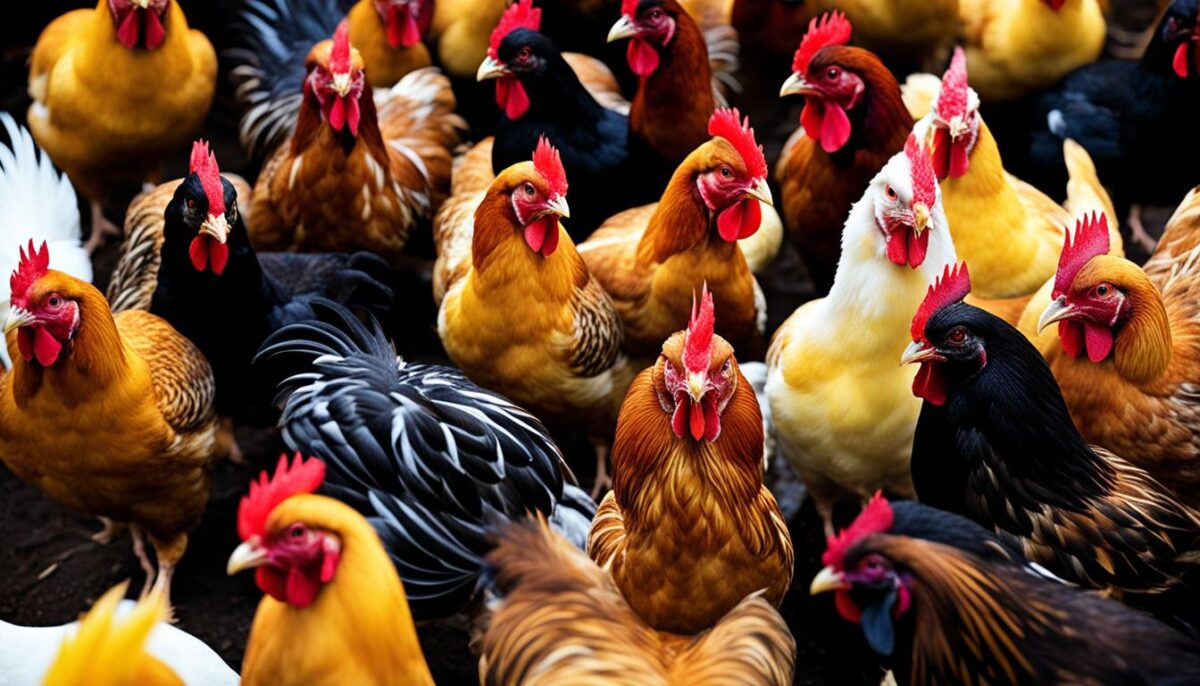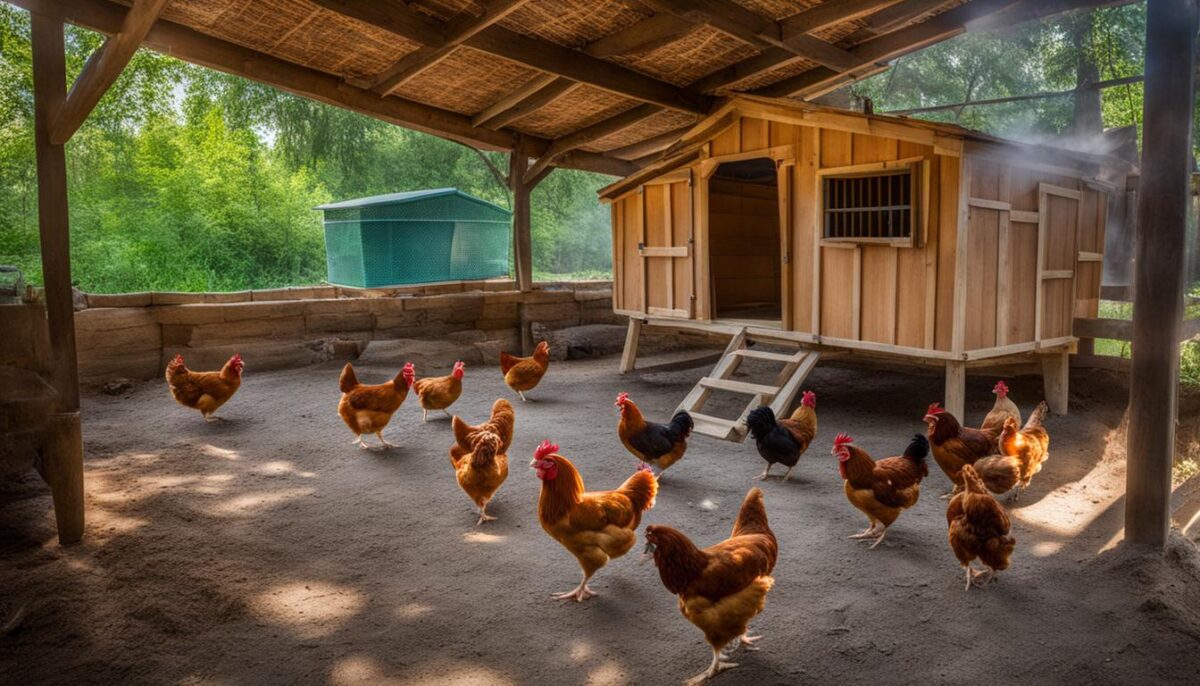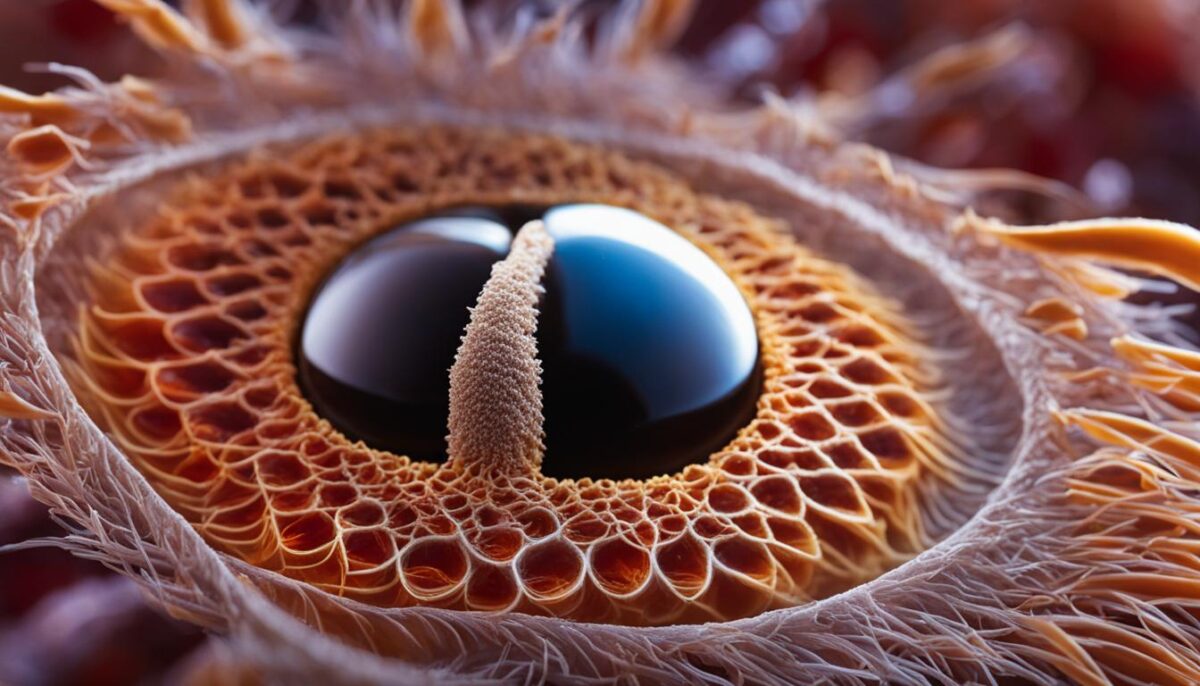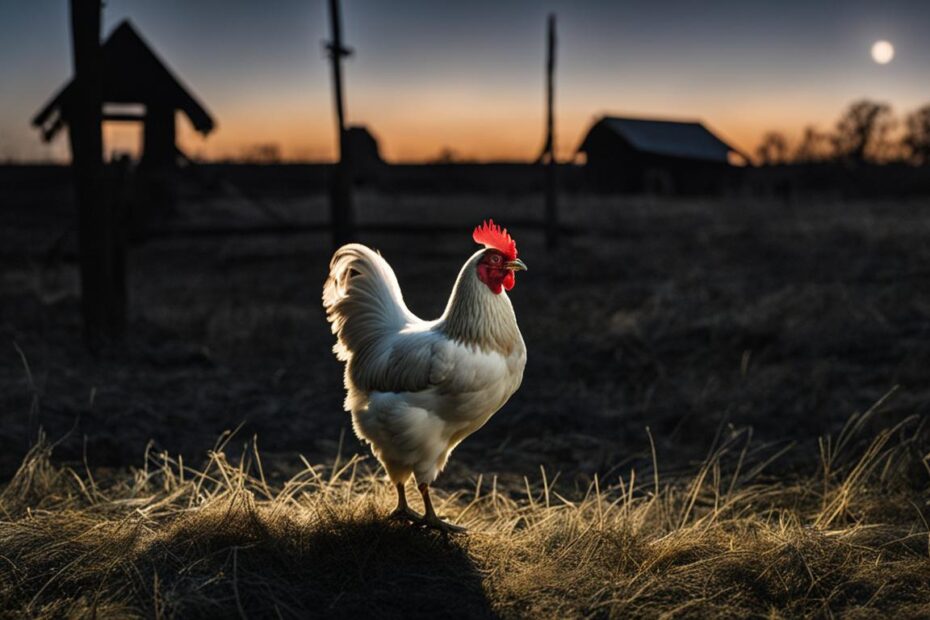Have you ever wondered if chickens can see in the dark? The vision of these feathered creatures has long been shrouded in mystery. In this article, we will explore the fascinating world of poultry vision and shed light on whether chickens possess the ability to see clearly when the lights go out.
Chickens, unlike humans or nocturnal animals, have poor vision at night. They are often referred to as having night blindness. This is because chickens lack the necessary number of light-sensitive photoreceptors called rods in their retinas, which limits their ability to see in the dark. However, they do have excellent color vision.
In this article, we will delve into the science behind chicken night vision and understand the unique characteristics of their eyes. We will also explore the significance of eye color in chickens and how it can provide valuable insights into their health. Finally, we will discuss tips for maintaining good eye health in chickens and considerations for breeders and hobbyists.
Key Takeaways:
- Chickens have poor vision at night and are often referred to as having night blindness.
- The low number of light-sensitive photoreceptors called rods in their retinas limits their night vision capabilities.
- Chickens have excellent color vision due to their abundance of cones in their eyes.
- Eye color in chickens can provide insights into their health and may be linked to certain diseases or health issues.
- Maintaining good eye health in chickens involves practicing proper hygiene and regular monitoring of eye color.
The Science Behind Chicken Night Vision
Have you ever wondered about the ability of chickens to see in the darkness? It turns out that chickens have evolved from dinosaurs and have excellent day vision but poor night vision. While they have more types of cones in their eyes than mammals, allowing them to see a wider range of colors, their low sensitivity to light makes it challenging for them to see in dark environments.
Chickens have a double-cone structure in their retinas, which enhances their sensitivity to movement. This is especially useful during the day when they can easily spot predators or prey. However, when it comes to navigating in dim light or darkness, chickens struggle due to their limited night vision capabilities.
Research has shown that chickens have poor visual acuity in dark environments. Their retinas contain a low number of light-sensitive photoreceptors called rods, which are responsible for detecting light in low-light conditions. This lack of rods makes it difficult for chickens to see in the dark, leading to their reputation for night blindness.
While chickens may not have the best night vision, they still have remarkable vision during the day. Their ability to perceive a wide range of colors and detect movement is a testament to their survival and adaptation over thousands of years. Understanding the science behind chicken night vision can help us appreciate the unique capabilities of these remarkable birds.
Table: Comparative Visual Acuity in Dark Environments
| Chickens | Nocturnal Animals | |
|---|---|---|
| Visual Acuity | Low | High |
| Light Sensitivity | Low | High |
| Number of Rods | Low | High |
| Color Vision | Excellent | Limited |
Understanding Chicken Eye Colors
Chicken eyes come in a variety of colors, each adding a unique touch of beauty to these fascinating creatures. The color of a chicken’s eyes is not only aesthetically pleasing but can also provide insights into their health and well-being. Let’s explore the different eye colors seen in chickens and what they might signify.
Common Eye Colors in Different Breeds
While brown eyes are the most common in standard chicken breeds, some breeds boast more unique eye colors. For example, Araucanas and Ameraucanas are known for their blue and green eyes, adding a touch of elegance to their appearance. Ayam Cemani chickens, on the other hand, have striking ruby-red eyes that make them truly stand out.
To better understand the significance of eye color in chickens, let’s take a closer look:
| Breed | Common Eye Color |
|---|---|
| Standard breeds | Brown |
| Araucanas and Ameraucanas | Blue and Green |
| Ayam Cemani | Red |
Table: Common eye colors in different chicken breeds.
Eye Color and Health
Believe it or not, eye color can play a role in assessing the health of chickens. Changes in eye color may indicate underlying health issues or diseases, providing caretakers with early warning signs that something may be amiss. By regularly monitoring the eye color of chickens, caretakers can detect potential problems early on and seek appropriate veterinary care.
“Regular monitoring of eye color is crucial for the early detection of health issues.”
Maintaining good eye health in chickens is essential for their overall well-being. Practicing proper hygiene and biosecurity measures, such as keeping the coop clean and dry, providing adequate ventilation, and implementing biosecurity protocols, can help prevent eye infections and maintain optimal eye health.
“Good eye health in chickens can be maintained through proper hygiene and husbandry practices.”
Understanding the significance of eye color and prioritizing good eye health can contribute to the overall health and happiness of your flock.
Genetic Mutations and Unique Eye Colors
Genetic mutations play a fascinating role in the development of unique eye colors in chickens. These mutations can result in eye colors that are not commonly seen in standard breeds. One example is the albino chicken, which has pink eyes due to a complete absence of pigmentation. This lack of pigmentation affects the color of the eyes, giving them a distinct and captivating appearance. On the other end of the spectrum, there are melanistic chickens that have an excess of melanin pigmentation, resulting in black eyes. These stunning eye colors are a result of genetic mutations that alter the pigmentation levels in the eyes.
Aside from pink and black, genetic mutations can also give rise to other unusual eye colors in chickens. Some breeds may exhibit eye colors like violet or lavender due to specific genetic variations. These unique eye colors add a touch of beauty and individuality to the chickens, making them stand out from the crowd. The rarity and beauty of these eye colors make them highly sought-after among chicken enthusiasts and breeders alike.
Understanding the genetic mutations that contribute to unique eye colors in chickens is an ongoing area of research. Scientists and breeders are continually studying the genes responsible for these mutations in order to gain a deeper understanding of the underlying genetic mechanisms. This knowledge can help breeders selectively breed for desired eye colors while ensuring the overall health and well-being of the chickens. Genetic testing has become an important tool in poultry genetics, providing valuable insights into the inheritance of eye color traits.

Eye Color and Its Significance for Chicken Health
Monitoring the eye color of chickens is an important aspect of poultry care as it can provide valuable insights into their overall health. Changes in eye color may indicate underlying health issues or diseases, allowing caretakers to take early detection and treatment measures. Regular monitoring of eye color is crucial for the early detection of potential health problems.
When observing a chicken’s eye color, it is essential to keep in mind that different breeds exhibit various common eye colors. Standard breeds commonly have brown eyes, while Araucanas and Ameraucanas may have blue or green eyes. Ayam Cemani, on the other hand, is known for its striking red eyes. These variations in eye color can be informative when it comes to assessing the health of individual chickens.
To effectively monitor eye color, it is best to establish a baseline for each chicken when they are healthy. This baseline can serve as a reference point for detecting any changes in eye color, such as the appearance of redness, cloudiness, or discoloration. Regularly comparing the current eye color to the established baseline can help identify potential health issues promptly.
Table: Eye Colors and Possible Health Indications
| Eye Color | Possible Health Indications |
|---|---|
| Brown | Typical and healthy eye color for most breeds |
| Blue or Green | Normal eye color for Araucanas and Ameraucanas |
| Red | Normal eye color for Ayam Cemani |
| Cloudiness or Discoloration | Possible sign of eye infection or disease |
| Redness | Indication of potential inflammation or infection |
Regular monitoring of eye color can help caretakers identify any changes that may be indicative of underlying health issues, enabling them to provide timely care and treatment. It is essential to establish a baseline eye color for each chicken and compare it to the current color during routine observation. By keeping a close eye on their eye color, caretakers can take proactive measures to maintain the health and well-being of their chickens.
Maintaining good eye health in chickens involves practicing proper hygiene and biosecurity measures. Keeping the coop clean and dry, providing adequate ventilation, and practicing biosecurity can help prevent eye infections. Regular monitoring of eye color is crucial for early detection of potential health issues, allowing caretakers to take prompt action to address any problems that may arise.
Maintaining Good Eye Health in Chickens
Ensuring the good eye health of chickens is crucial for their overall well-being. By implementing proper biosecurity measures and regularly monitoring their eye color, caretakers can prevent eye infections and detect potential health issues early on.
To maintain good eye health, it is important to practice proper hygiene in the chicken coop. Keeping the coop clean and dry helps prevent the buildup of bacteria and other pathogens that can lead to eye infections. Adequate ventilation is also essential to reduce humidity and promote fresh air circulation, which can help prevent respiratory diseases that may affect the eyes.
Implementing biosecurity measures is another important aspect of maintaining good eye health in chickens. This includes limiting access to the coop and ensuring visitors and caretakers follow hygiene protocols, such as washing hands and disinfecting footwear before entering. Additionally, monitoring and controlling pests like flies can help prevent eye irritations and infections.
Regular monitoring of eye color
A crucial part of maintaining good eye health in chickens is regular monitoring of their eye color. Changes in eye color can often be an early indicator of underlying health issues. By observing the color of the chickens’ eyes, caretakers can identify potential problems and seek appropriate veterinary care.
During eye color monitoring, caretakers should look for any signs of redness, inflammation, cloudiness, or discharge. These may indicate infections, allergies, or other health conditions. Additionally, changes in the brightness or intensity of the eye color should be noted as they can also be indicative of health issues.
By practicing proper biosecurity measures and regularly monitoring the eye color of chickens, caretakers can ensure the maintenance of good eye health. Early detection of eye problems allows for prompt treatment, minimizing the risk of complications and promoting the overall well-being of the chickens.

Considerations for Breeders and Hobbyists
Breeders and hobbyists play an important role in the world of chicken breeding, with the ability to selectively breed for desired traits. When it comes to chicken eye colors, breeders can carefully choose their breeding pairs to achieve specific eye color variations. However, it is crucial to prioritize breeding for healthy eyes and vision above all else. Aesthetics should not compromise the overall well-being of the chickens.
Genetic testing can be a valuable tool for breeders, providing insights into specific eye color traits and allowing for informed breeding decisions. By identifying the genes responsible for eye color variations, breeders can better understand the underlying genetic mechanisms and work towards breeding chickens with healthier eyes and enhanced vision.
It is important to note that while eye color can be an interesting aspect of chicken genetics, it is just one piece of the puzzle. Breeders should consider other factors such as overall health, temperament, productivity, and breed standards when making breeding decisions. By taking a holistic approach, breeders can contribute to the development of healthier and more robust chicken populations.
Table: Eye Color Variations in Different Chicken Breeds
| Breed | Common Eye Colors |
|---|---|
| Standard Breeds | Brown |
| Araucanas and Ameraucanas | Blue, Green |
| Ayam Cemani | Red |
| Specific Breeds/Genetic Mutations | Violet, Lavender (Genetic Mutations) |
“Selective breeding for desired eye colors can be a fascinating endeavor for breeders and hobbyists. However, it is crucial to prioritize the overall health and well-being of the chickens.”
By focusing on breeding for healthy eyes and vision, breeders and hobbyists can contribute to the long-term success and vitality of their flocks. With careful consideration and a commitment to ethical breeding practices, breeders have the opportunity to make a positive impact on the genetic diversity and overall health of chickens.
Technological Advances in Studying Chicken Eyes
Genetic research and technological advances have revolutionized our understanding of chicken eyes. Scientists have been able to delve into the intricate genetic makeup of chickens and map the genes responsible for eye color variations. This has provided valuable insights into the underlying genetic mechanisms behind eye color in these fascinating creatures.

Advancements in Genetic Research
With the help of advanced genetic techniques, researchers can now identify and study specific genes that control eye color in chickens. By mapping the genome of various chicken breeds, scientists have been able to pinpoint the genetic variations that give rise to different eye colors. This has opened up new possibilities for selective breeding and the development of unique eye colors in poultry populations.
Technological Tools and Techniques
Technological advances have also facilitated the development of innovative tools and techniques for studying chicken eyes. Scientists can now analyze the expression of specific genes, study the proteins involved in eye development, and examine the structure of the eye tissues at a microscopic level. These advancements have provided a deeper understanding of the molecular processes underlying eye color and vision in chickens.
Implications for Breeders and Researchers
The use of genetic research and technological advancements in studying chicken eyes has significant implications for breeders and researchers alike. Breeders can now utilize genetic testing to identify desirable traits and make informed breeding decisions. They can selectively breed for specific eye colors while ensuring the overall health and well-being of the chickens.
In addition, researchers can gain valuable insights into the evolution of eyes and vision in chickens. This knowledge can contribute to our understanding of vision in other species and potentially lead to advancements in human eye health research.
Overall, the combination of genetic research and technological advances has brought about remarkable progress in unraveling the mysteries of chicken eyes. This ongoing research continues to shed light on the unique visual capabilities and genetic diversity present in these remarkable birds.
Conclusion
In conclusion, chickens have limited vision in dim light conditions and struggle to see in the dark. While they have more cones in their eyes than mammals, allowing them to perceive a wider range of colors, their low sensitivity to light hampers their ability to navigate in darker environments. It is important to understand chicken eye colors and prioritize maintaining good eye health to ensure the well-being of these animals.
Regular monitoring of eye color can help detect potential health issues early on, enabling timely intervention and treatment. By practicing proper hygiene, maintaining a clean and dry coop, providing adequate ventilation, and implementing biosecurity measures, chicken owners can minimize the risk of eye infections and promote good eye health in their flock.
In addition, breeders and hobbyists should consider selectively breeding for healthy eyes and vision rather than solely focusing on eye color traits. Genetic testing and technological advancements have enabled researchers to gain a deeper understanding of the genetic mechanisms behind eye color variations in chickens, providing valuable information to inform breeding decisions.
While chickens may struggle to see in dim light conditions or at night, they still bring joy and companionship to many. By being aware of their visual limitations and taking appropriate measures to maintain their eye health, we can ensure that these feathered friends live happy and healthy lives.
FAQ
Can chickens see in the dark?
No, chickens have poor vision in the dark due to their limited night vision capabilities.
Do chickens have night vision?
No, chickens do not have night vision like humans or nocturnal animals.
What is the visual acuity of chickens in dark environments?
Chickens have poor night vision due to the low number of light-sensitive photoreceptors called rods in their retinas.
What are the different eye colors in chickens?
Chickens can have a variety of eye colors, including brown (most common in standard breeds), blue and green (Araucanas and Ameraucanas), and red (Ayam Cemani).
How do genetic mutations affect chicken eye colors?
Genetic mutations can give rise to unique eye colors in chickens, such as pink (albino) or black (melanistic) eyes. Certain breeds may also exhibit violet and lavender eye colors due to genetic mutations.
Can eye color indicate the health of chickens?
Yes, changes in eye color may indicate underlying health issues or diseases in chickens.
How can I maintain good eye health in chickens?
Good eye health in chickens can be maintained through proper hygiene and husbandry practices, such as keeping the coop clean and dry, providing adequate ventilation, and practicing biosecurity measures.
What should breeders and hobbyists consider regarding chicken eye colors?
While breeders and hobbyists can selectively breed for desired eye colors, it is important to prioritize breeding for healthy eyes and vision to ensure the overall well-being of the chickens.
What technological advances have been made in studying chicken eyes?
Technological advances have allowed for in-depth genetic research and mapping of chicken eyes, providing valuable information for breeders and researchers.
Can chickens see in dim light conditions?
Chickens have more cones in their eyes than mammals, allowing them to see a wider range of colors. However, their low sensitivity to light makes it difficult for them to see in dim light conditions.
Source Links
- https://www.hummingbirdsplus.org/nature-blog-network/chicken-eye-colors-exploring-unique-shades-in-different-breeds-and-mutations/
- https://www.farmanimalreport.com/2020/08/22/why-do-chickens-need-red-light-6-main-reasons/
- https://www.farmanimalreport.com/2020/07/06/are-chickens-blind-at-night-with-videos/


